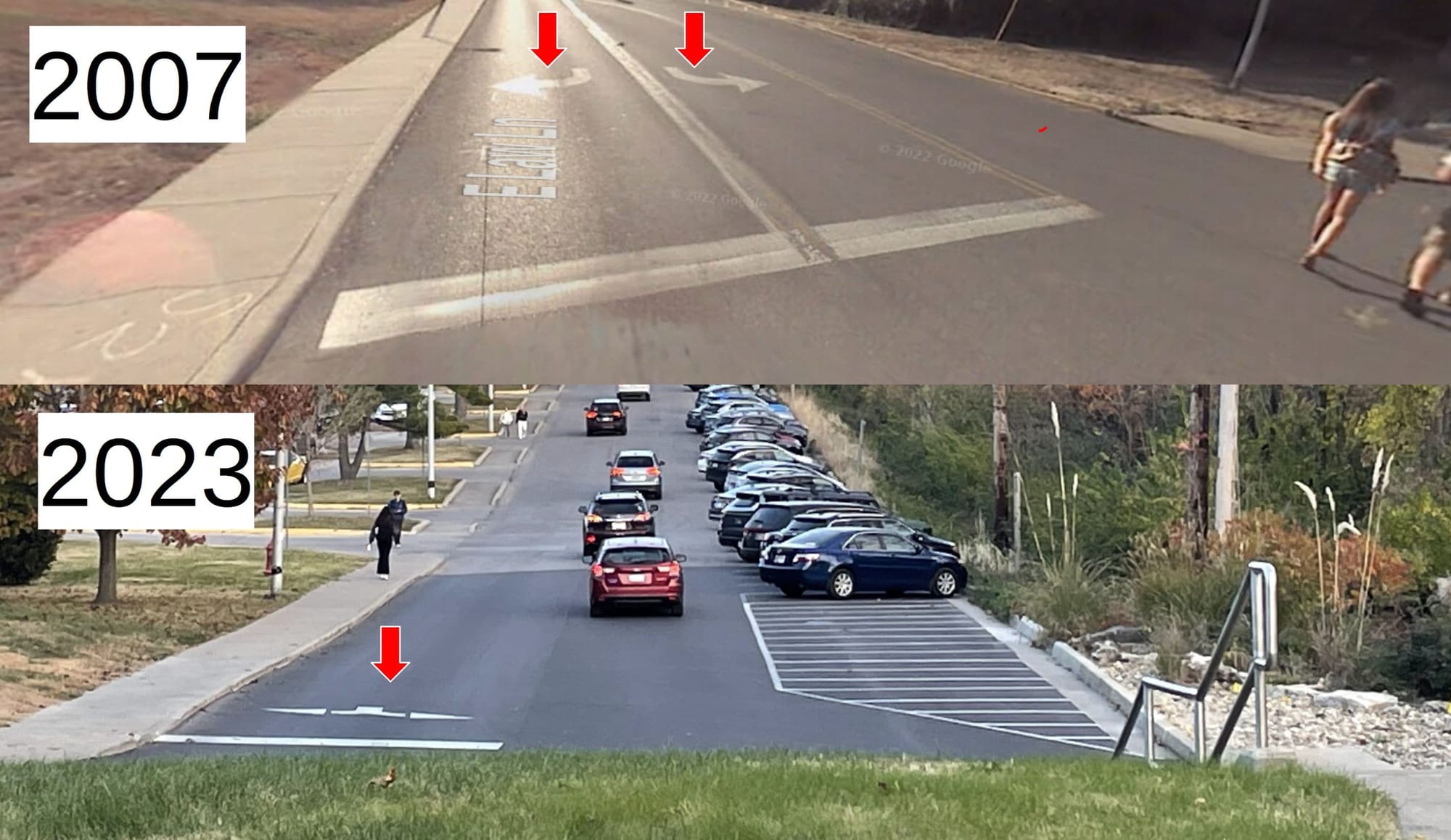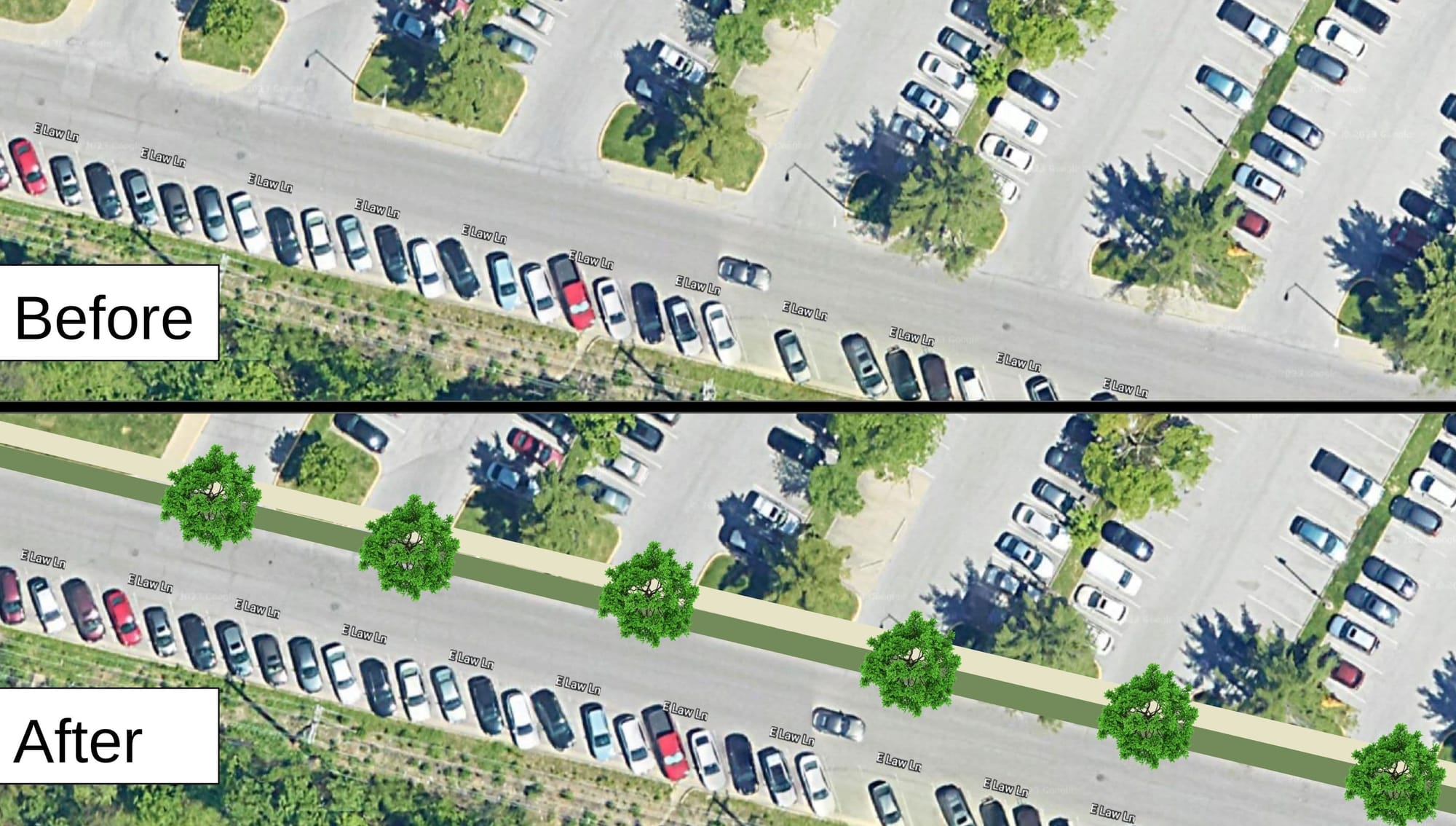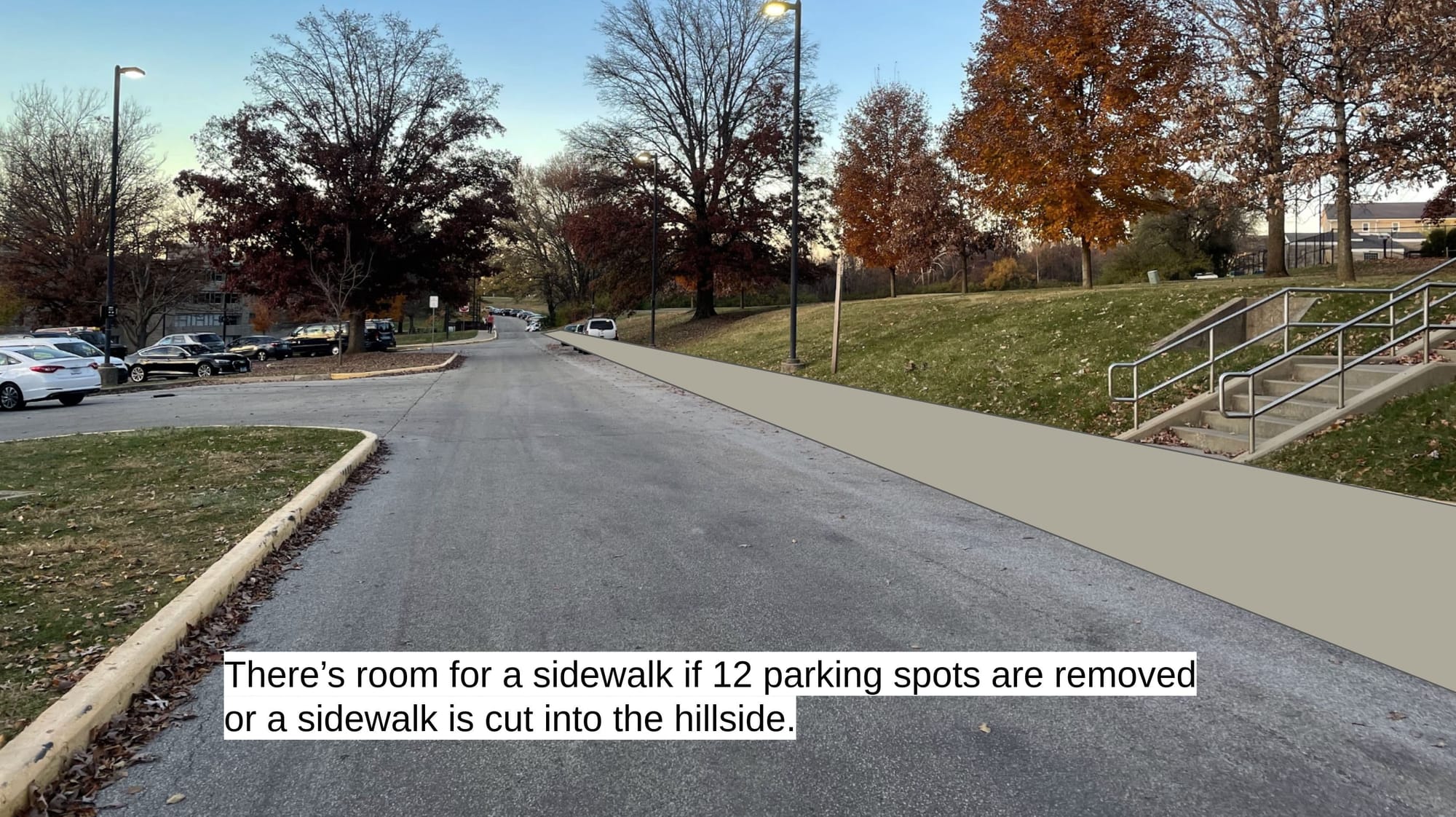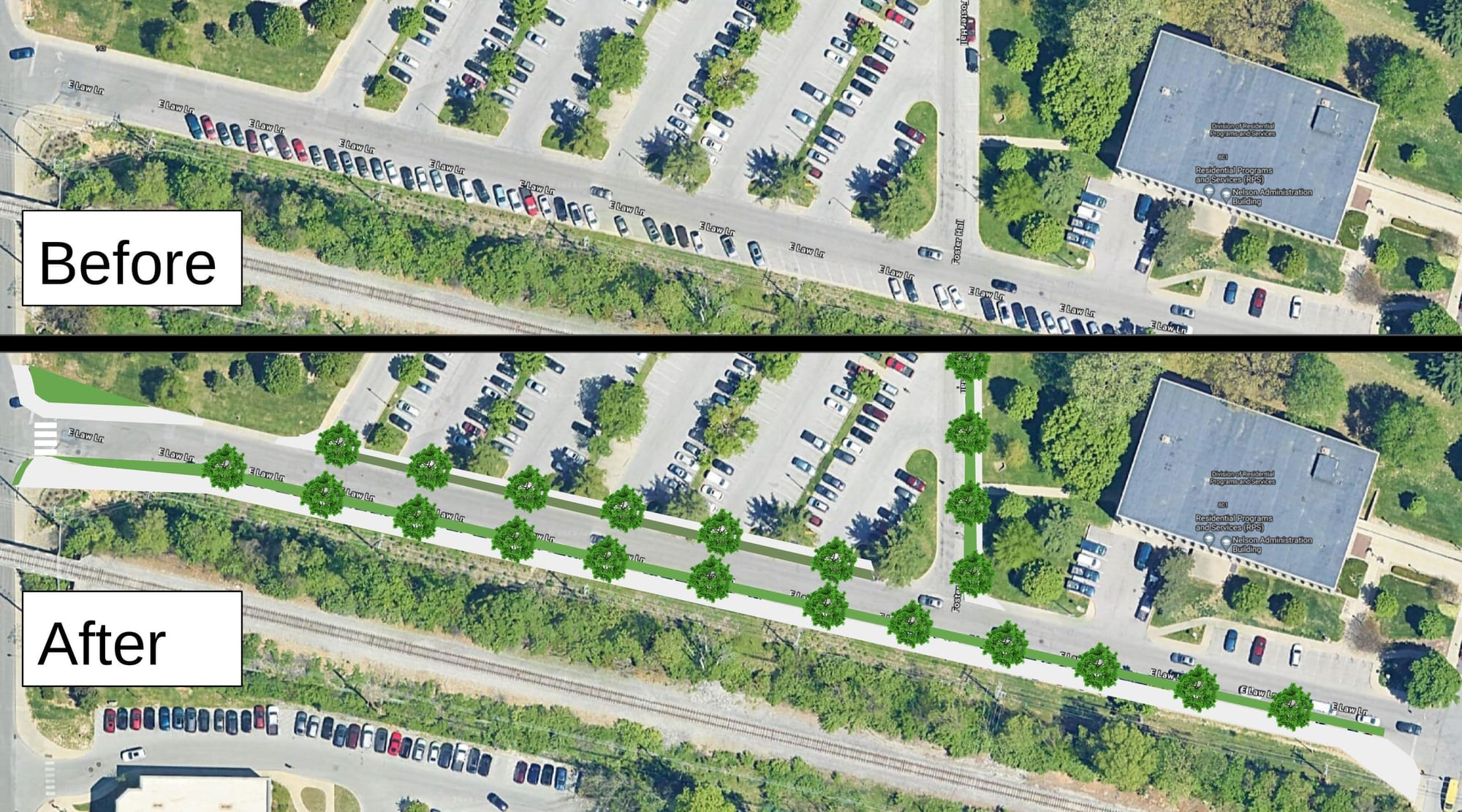Law Lane Pedestrian Safety Audit

Last year, a pedestrian was struck crossing Law Lane at Fee Lane in Bloomington, Indiana. Was this a one-off accident, or has there been a pattern of crashes at that intersection? Are there changes that could be made to improve pedestrian safety in the area?
I took a deep dive into the historical crash data, how the intersection design has changed over time, and how the current designs compare to best practices for safe and comfortable street design. Finally, my findings are compared against IU's Master Plan for the street.
Who owns Law Lane?
Although IU doesn't publish GIS data for the streets that they own, they can be approximated because the City of Bloomington publishes a map of their "city-maintained" streets and the campus boundary is public as well. With those, we can generate a map of the streets within the IU campus that are not maintained by the City of Bloomington.

We can see that Fee Lane is controlled by the City of Bloomington while Law Lane belongs to Indiana University, so the University is responsible for the safety of that street, while the intersection with Fee is shared with the City.
History of pedestrian-involved crashes at Law and Fee
The crash data records seven more pedestrian-involved crashes near the Law and Fee intersection from 2003-2022, in addition to the recent one. But there have been over 100 crashes of all types near that intersection during the same period. There's also a cluster of crashes near the intersection a block north, where there was a pedestrian fatality in 2009.
Audit of Law & Fee intersection design
How well does the intersection design of Law & Fee compare to best practices for pedestrian safety? There are three opportunities for improvement. The crossing distance, the intersection alignment, and adding a crosswalk. Let's look at those.

It's currently a 38-foot walk to get from one side of Law Lane to the other here, almost twice as long as needs to be: a 22-foot-crossing could work. A shorter crossing distance is important for several reasons:
- Less time crossing, which means less exposure to traffic
- Improve sightlines for both pedestrians and drivers, allowing them to see each other more easily.
- Reduce vehicle speeds due to the physical constraints and smaller effective turning radius
- Higher comfort. Crossing streets where crashes are more likely to happen is not comfortable.
To compare crossing distances, consider some other examples around town.

Just south of this intersection, there's a pedestrian crossing from a driveway that's only two lanes wide– much shorter. This is an example of an intersection that IU improved. Compare this to a historical photo of the same intersection, which was a three-lane crossing until IU narrowed it:

Another interesting comparison is the nearby intersection of Law and Eagleson, because IU narrowed one side of the street to a shorter two-lane crossing, but not the other.

Notice on how one side of the street the sidewalk expects to the edge of the parked cars but on the other side it does not. The difference is called a bump-out and is a treatment that the City of Bloomington is increasingly using around the city to improve pedestrian safety and comfort. Here's a recent example of bump-outs at Washington and Ninth:

Looking at the history of the Fee and Law intersection adds some interesting context here.

In 2007 and before Law Lane was designed with three travel lanes, as westbound traffic had dedicated left and right turn lanes. By 2023 those two turn lanes had been combined. But instead of shortening the crossing distance for pedestrians and narrowing the effective turning radius with a bump out, IU added some painted hash marks on the road. Even if the paint doesn't attempt to narrow the road fully to two lanes, but still encourages a wider and faster turning radius for cars on Fee turning on to law.
The lack of adding a painted crosswalk to this busy pedestrian crossing during this recent maintenance is somewhat inexplicable. Crosswalks are a well-established tool for pedestrian safety at intersections. They provide a visual cue to drivers of the potential presence of pedestrians and establish a clear right-of-way.
Finally, let's look at the intersection alignment. According to the Federal Highway Administration: In the design of new facilities or redesign of existing facilities where right-of-way is not restricted, all intersecting roadways should meet at a 90-degree. A 90-degree angle provides the best sightlines for drivers, allowing them to see approaching traffic and pedestrians more easily.
Here's a design that brings those three best practices together: a shorter crossing distance with a reduced turning radius, better intersection alignment, and a crosswalk.

Here it is again, in before/after format. Which intersection which you rather walk across?

That's a safer intersection design, but there's plenty more to improve about this block of Law Lane.
18 unnecessary conflict points with cars on a one-block walk
Consider the common walk home from campus up Fee towards the housing on Eagleson.

Every time a pedestrian route crosses a car route, that's a conflict point. Crossing a two-way street, parking lot, or driveway exit is two conflict points. So there are 18 conflict points on this one-block walk. The majority of these conflict points, 12, are due to crossing six exits of the Foster Quadrangle lot, which has nine exits in total. Does nine parking lot exits seem like a lot? It is. Every other lot nearby has just one or two exits.

An updated design could eliminate 12 conflict points by closing the six parking lot exits to Law Lane, still leaving three exits– more than any other nearby lot. Trees could be planted and the sidewalk could moved a few feet to create a buffer of grass between the sidewalk and the cars. Those buffers improve both safety and comfort.

Here's the same thing, presented as before vs after:

There's also a very cheap and fast version of this intervention to try: start blocking each of these six exits with some heavy planters.
I was talking to a graduate student about safety concerns on Law Lane and he shared a story that he had been hit by a car leaving one of these exits as he was biking to class. He was able to get up and continue to class. That crash did not get formally reported and is one of many crashes that don't have formal report files. With so many opportunities for conflict along Law Lane, the odds are higher that there will be a crash there in the future with a serious injury or worse.
Foster Drive has no sidewalk.
Moving further east up Law Lane, there's a street heading north named Foster Drive. On this section of Foster Drive, there are no sidewalks at all.

So far the proposed design updates have not involved removing parking spaces, but at some point, trade-offs have to be considered between the safety of comfort of people walking in a space and how much car storage is being offered.
To add a sidewalk on this stretch of Foster Lane, IU could either cut further into the hillside or remove 12 parking spots. Here's a mockup of converting 12 parking spots into a sidewalk.

Unsafe backing crashes
Looking at the crash reports from 2003-2022 along Law Lane between Fee and Eagleson, most of them have a primary factor "unsafe backing", meaning a primary cause is related to someone backing out of the angle-in parking there. Here's a visualization.

There's a trend around the country of replacing more angle-in parking with back-in parking because it tends to be safer. It's much easier to see where you are going if you are facing forward. Changing the direction of the parking would be another cheap intervention to attempt to reduce crashes here, but there's another factor that compounds the risk in the current situation. At Foster Drive, people are not only backing into traffic, they are backing into an intersection!

Even if no other remediation was done, removing the parking spots that back directly into the intersection would address a higher-risk crash location.
There is an even more ambitious opportunity to turn Law Lane into one of the best blocks for walking at IU instead of one of the worst.

Here's a before/after comparison that includes all the intersection fixes, closing parking lot exits, adding a multi-use path on the south side, and adding a sidewalk on Foster Drive.

Will IU be making safety improvements like this to Law Lane?
After I completed this audit and recommendations for Law Lane, I found a design for a "Law Lane Extension" published as a plan in a 2020 IU Bloomington Master Plan update. This provides some details of what a Law Lane update could look like, but the "concept of a plan" for a Law Lane update appears in the earlier 2010 Master Plan, described like this:
The extension to East Law Lane will traverse through the southern edge of the Fee Lane Area neighborhood, creating a much needed vehicular-oriented east-west connection. This new passageway will help ease congestion on East Tenth Street. The new roadway should include bike lanes and off-street pedestrian sidewalks to encourage all modes of transportation. (From 2010 IU Master Plan)
This provides the unique opportunity to compare my independent recommendations to IU's actual plans.


There's a lot here. The graphic from the PDF was unfortunately low quality. Here's how it compares to the pedestrian safety audit recommendations here.
Positive changes in IU's Law Lane plan
- ✅ 13th & Fee, the location of a pedestrian fatality, would be closed to car traffic.
- ✅ Crossing distance at Law and Fee has been shortened.
- ✅ Five exits to the Foster Quadrangle lot would be closed
- ✅ Trees added along the Foster Quadrangle lot
- ✅ Sidewalks on the north side of Law Lane would be set back from the street with a grass buffer.
- ✅ All the angle-in parking on Law Lane has been removed and appears to be replaced with a multi-use path. Some removed parking is offset by new parallel parking added. Overall I would guess that more parking was removed than was added.
- ✅ Potential traffic signal at Law and Fee
- ✅ Shorter pedestrian crossing distance at Law and Eagleson
Overall, several improvements should improve safety and reduce crash rates
Opportunities for improvement in IU's Law Lane plan
- ❓ The draft doesn't show crosswalks.
- ❓ The intersection of Law and Fee has not been re-aligned to 90 degrees for the best sign lights even though there is room to do so.
- ❓No sidewalk was added to Foster Drive. It would be a minor addition to the scope of this ambitious project.
When is IU going to update Law Lane?
There are no definitive timelines for this in the IU Master Plan and the last update was published almost five years ago. The project could certainly be phased. If IU wanted to prioritize updating the poor walking experience on Law Lane between Fee and Eagleson, I imagine they could find a way to do that. Petition the IU administration if you'd like to see this move forward sooner rather than later.



Comments ()